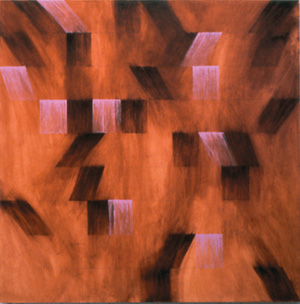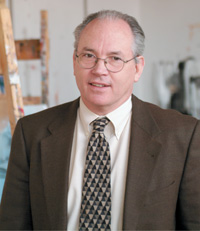|
Art and the Liberal Arts: Integrating Thought and
Action
 “Art
requires the integration of thought and action,”
says Power Boothe ’67. “That’s
what happens in the studio, and that’s what
I believe an arts education should be about. At
CC, I learned how to engage the world around me
as an artist, and for my own “Art
requires the integration of thought and action,”
says Power Boothe ’67. “That’s
what happens in the studio, and that’s what
I believe an arts education should be about. At
CC, I learned how to engage the world around me
as an artist, and for my own
self-education.”
Boothe made that choice when
he pursued a rigorous liberal arts education at
Colorado College despite plenty of encouragement
to stay at the California School of Arts and Crafts,
where he’d studied during high school. “At
Arts and Crafts, I developed facility, but I wanted
the other piece of the puzzle — what is going
on in the world and how my work connects to it,”
he says. “At CC, I was able to take physics,
philosophy, English, as well as excellent studio
art courses. It’s important to know not only
how to make things, but also what your work is about.”
The late Bernard Arnest, then-chair of CC’s
art department, helped Boothe transfer credits for
his college-level work at Arts and Crafts, and three
years later, helped him apply to a fellowship program
at the Whitney Museum’s independent study
program — the step that launched Boothe professionally
in New York City. “My career went very well,
very early,” he says. “It was also fascinating
to visit the gallery that represented Bernard’s
work and find out how highly regarded he was in
New York.
 “He was a very good painter, and a thoughtful
and elegant person, tremendously flexible and encouraging.
He also hired Herman Snyder, a sculptor who was
on the cutting edge of contemporary art, who had
a major impact on CC art students of my era.
“He was a very good painter, and a thoughtful
and elegant person, tremendously flexible and encouraging.
He also hired Herman Snyder, a sculptor who was
on the cutting edge of contemporary art, who had
a major impact on CC art students of my era.
“There was a lot of controversy around Herman,
but he encouraged us to go to New York City and
make work that was meaningful to us. It was the
way he felt about being an artist: ‘You can
think of art as a product or a process. If your
focus is on making things for a known market, you
become conservative quickly. But if your art is
part of a larger exploration, it will evolve from
the questioning process.’ He challenged his
students to make work that was less polished but
more culturally challenging — engaged in political,
social, cultural, biological, psychological issues.
Those two guys (Arnest and Snyder) gave me two sides
of the coin. It was a potent combination.”
After 30 years as a full-time artist — painter,
set designer, filmmaker — in New York City
with frequent forays into teaching, Boothe switched
to working full-time as an educator with frequent
sojourns in the studio. He’s now dean of the
Hartford Art School at the University of Hartford,
Conn., where he was drawn partly by the art school’s
close connection to the liberal arts.
Power
Boothe says his mentor, the late Professor Bernard
Arnest, modeled how to be an administrator,
an artist, and an educator.
“I was concerned about my ability to do
well in college and as an artist — I was
not at all confident I would be able to succeed
in the world. He saw my potential and made the
case that I should be at CC instead of art school,
and that I should go to New York City.
I really felt he was looking out for us as individuals;
he kept seeing what I could do before I did.
In a sense, he gave me the momentum to take
charge of my own career — it began with
him.” |
“It represents what I believe is the ideal
background for any artist,” says Boothe. “I
don’t want to make any rules, but I cannot
imagine a better way to educate an artist than to
combine the liberal arts with a studio experience.”
– Anne Christensen
|